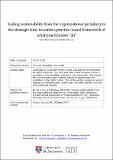Files in this item
Scaling sustainability from the organizational periphery to the strategic core : towards a practice-based framework of what practitioners “do”
Item metadata
| dc.contributor.author | Birrell Ivory, Sarah | |
| dc.contributor.author | Mackay, R. Bradley | |
| dc.date.accessioned | 2022-03-20T00:40:10Z | |
| dc.date.available | 2022-03-20T00:40:10Z | |
| dc.date.issued | 2020-07 | |
| dc.identifier | 266467027 | |
| dc.identifier | e952bba0-8538-4be5-bb44-0621ef1929f1 | |
| dc.identifier | 85082055644 | |
| dc.identifier | 000520758100001 | |
| dc.identifier.citation | Birrell Ivory , S & Mackay , R B 2020 , ' Scaling sustainability from the organizational periphery to the strategic core : towards a practice-based framework of what practitioners “do” ' , Business Strategy and the Environment , vol. 29 , no. 5 , pp. 2058-2077 . https://doi.org/10.1002/bse.2487 | en |
| dc.identifier.issn | 1099-0836 | |
| dc.identifier.other | ORCID: /0000-0001-8737-3018/work/82788656 | |
| dc.identifier.uri | https://hdl.handle.net/10023/25070 | |
| dc.description.abstract | This paper explores what sustainability managers do when attempting to scale sustainability to a strategic level within their organization. Drawing on semistructured interview data with 44 sustainability managers in large, for‐profit companies, we identify three distinct scaling microstrategies that individuals use when scaling sustainability. We label these conforming, leveraging, and shaping. Our analysis also finds that sustainability managers deploy combinations of these microstrategies in three distinct approaches, which we call the assimilation approach, the mobilization approach, and the transition approach. Finally, we interrogate the degree to which employing these different approaches achieves a peripheral, intermediate, or strategic scale of sustainability within the organizations represented in the study. Our paper contributes to theory and practice at the interface of strategy and sustainability by developing a practice‐based Scaling Approach Framework, whereby an assimilation approach is associated with organizations with sustainability at a peripheral scale, a mobilization approach is associated with an intermediate scale of sustainability, and a transition approach is associated with scaling sustainability to a strategic level. From these results, we propose a Scaling Progression Model that reflects the phases that individuals progress through when scaling sustainability. | |
| dc.format.extent | 974828 | |
| dc.language.iso | eng | |
| dc.relation.ispartof | Business Strategy and the Environment | en |
| dc.subject | Microstrategy | en |
| dc.subject | Scaling | en |
| dc.subject | Scaling approach | en |
| dc.subject | Strategy | en |
| dc.subject | Sustainability | en |
| dc.subject | HD28 Management. Industrial Management | en |
| dc.subject | NDAS | en |
| dc.subject.lcc | HD28 | en |
| dc.title | Scaling sustainability from the organizational periphery to the strategic core : towards a practice-based framework of what practitioners “do” | en |
| dc.type | Journal article | en |
| dc.contributor.institution | University of St Andrews. Office of the Principal | en |
| dc.contributor.institution | University of St Andrews. School of Management | en |
| dc.identifier.doi | 10.1002/bse.2487 | |
| dc.description.status | Peer reviewed | en |
| dc.date.embargoedUntil | 2022-03-20 |
This item appears in the following Collection(s)
Items in the St Andrews Research Repository are protected by copyright, with all rights reserved, unless otherwise indicated.

